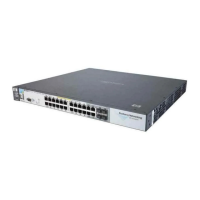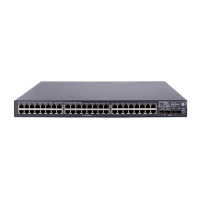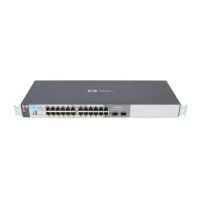10 Gigabit performance traffic patterns
In the prior table, the performance levels for 10 Gigabit ports assume the underlying traffic patterns reflect
either one of the following minimum conditions to achieve wire-speed throughput.
•A single source traffic stream with an average packet size of 88 bytes or larger
•Two or more source traffic streams of any packet size down to the minimum value of 64 bytes
In the unlikely case where the average packet size is consistently smaller, the throughput will be less than wire-
speed. For example, consider a worst case scenario where the average packet size is 64 bytes. This would
result in a throughput of approximately 70% to 80% of the rated wire-speed capacity. HP ProCurve considers
such minimum-sized packet traffic scenarios being realized over an extended period of time to be extremely
atypical and unlikely to be experienced by customers in the field.
NOTE: The limits described above do not apply to Gigabit ports.
Throughput test
A fully meshed performance test sends packets from each port to every other port during the test. This type of
test exercises both the modules and the backplane. These tests show the HP ProCurve Switch 8200zl, 5400zl,
3500, and 6200yl series to be wire-speed on all ports simultaneously.
Latency measurements
Latency is commonly measured as the amount of time it takes for a byte inside a packet to enter and then
leave the switch. Latency statistics are typically documented as including both the processing time of the switch
as it makes its forwarding decision and the time for the packet itself to enter and leave the switch. In the prior
tables, this definition of latency corresponds to the FIFO latency statistics. The LIFO latency statistics that are
also listed in the tables represent only the packet transmission time.
Almost all switches currently on the market are store and forward, so the entire packet is received into the
switch before the switch begins to transmit the packet out the egress port. Including the packet receive time in
the FIFO latency statistics is appropriate since this extra time is a contributing component of the overall transit
time of the packet as it moves through the network.
The latency figures for the HP ProCurve Switch 8200zl, 5400zl, 3500, and 6200yl series are consistently
low. Latencies this low will not be a factor in general network operation, even with streaming video or VoIP
applications. The LIFO latency values are fairly consistent across all packet sizes because ingress and egress
packet processors operate on the header of the frame (not the whole frame), while the full frame is buffered in
and out of packet buffer memory. Memory transfers are scheduled to fit a full 1518-byte frame, so frames are
transferred in and out of memory in approximately the same amount of time regardless of packet size. While
the frame headers are being looked up and actions required for the frame on egress are being coordinated
among interface modules, the frame is transferred through the switching fabric module.
55
